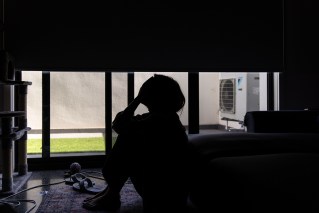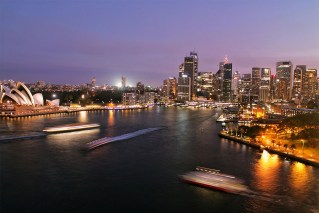Annual Islamic hajj pilgrimage scaled back due to COVID-19 concerns
Pilgrims wearing face masks and moving in small groups after days in isolation have began arriving at Islam’s holiest site in Mecca for the start of a historically unique and scaled-down hajj experience reshaped by the coronavirus pandemic.
This year marks the first time in nearly a century of Saudi rule over Mecca that people from outside the kingdom will not take part in the five-day pilgrimage, which is a once-in-a-lifetime pilgrimage for Muslims.
Rather than standing and praying shoulder to shoulder in a sea of people from different walks of life, pilgrims this year were standing apart.
They moved in small groups of 20 to limit exposure and the potential transmission of the coronavirus.

A small number of pilgrims circulate around the Kaaba, the square structure in the Great Mosque, toward which believers turn when praying, in Mecca. Photo: AP
In place of the 2.5 million pilgrims who performed the hajj last year, only 1000 to 10,000 have been allowed to take part in what is largely a symbolic pilgrimage amid the outbreak.
About 1000 people already residing in Saudi Arabia were selected to take part in the hajj this year.
Two-thirds are foreign residents from among the 160 different nationalities that would have normally been represented at the hajj.
One-third are Saudi security personnel and medical staff.
All pilgrims had to be between the ages of 20 and 50 with no terminal illnesses and showing no symptoms of the coronavirus.
Pilgrims were tested for the coronavirus, given wristbands to monitor their movement and required to quarantine at home and in their hotel rooms in Mecca ahead of Wednesday’s (local time) start of the hajj.
They have also been required to quarantine for a week after the hajj concludes.
Last year, the pilgrimage drew more than 2.5 million people to Mecca from across the world.
What is the hajj?

The hajj pilgrimage helps Muslims to deepen their faith and fulfil one of Islam’s five pillars. Photo: AP
The hajj has been considered one of Islam’s most important and profound requirements, performed once in a lifetime.
The pilgrimage follows the route the Prophet Muhammad walked nearly 1400 years ago and is believed to ultimately trace the footsteps of the prophets Ibrahim and Ismail, or Abraham and Ishmael as they are named in the Bible.
During the pilgrimage, a small number of pilgrims circulate the Kaaba, the square structure in the Great Mosque, toward which believers turn when praying, in Mecca.
The hajj, both physically and spiritually demanding, has been intended to bring about greater humility and unity among Muslims.
The pilgrimage is a journey that Muslims traditionally experience with relatives.
In past years, it was common to see men pushing their elderly parents around on wheelchairs in order to help them complete the hajj, and parents carrying children on their backs.
The communal feeling of more than 2.5 million people from around the world — Shiite, Sunni and other Muslim sects — praying together, eating together and repenting together has long been part of what makes hajj both a challenging and rewarding experience for worshipers.
This year, however, pilgrims have been eating pre-packaged meals alone in their hotel rooms and praying at a distance from one another.
While the experience has been starkly different, it remained an opportunity for pilgrims to deepen their faith and fulfil one of Islam’s five pillars.
–ABC/wires








